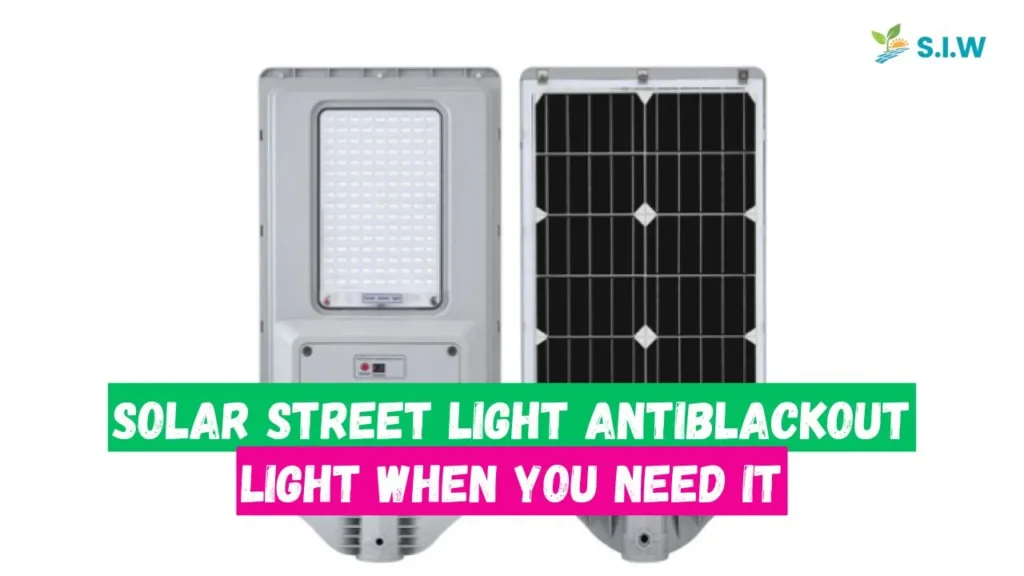Imagine walking down a street after dark, only to find the lights have gone out. It’s unsettling, and it raises safety concerns. That’s where solar street light antiblackout technology shines—literally. By utilizing solar power combined with a backup system, these lights stay on even during power failures, ensuring streets are illuminated when it’s needed the most.
What is a Solar Street Light Antiblackout?
A solar street light antiblackout system is an advanced solar lighting solution designed to remain functional even when the central grid fails. Unlike conventional street lights, these systems store solar energy during the day, then use this energy to power the lights at night, with the antiblackout feature ensuring they stay on during blackouts.
Why Solar Street Lights?
Harnessing Solar Energy
Solar street lights harness the sun’s energy, converting it into electricity without burning fossil fuels. They represent a greener solution for communities and cities, and they reduce reliance on traditional power sources that can experience blackouts.
Reduced Grid Dependency
With solar lighting, dependency on the electrical grid is minimized. These lights function independently, meaning they’re ideal for rural areas, parks, and streets where extending power lines would be costly.
Importance of Antiblackout Feature
In areas prone to power outages, the antiblackout feature is a game-changer. This technology keeps the lights on, contributing to safety and security. In emergencies or adverse weather, when the electrical grid may fail, antiblackout solar lights can be life-saving, offering reliable illumination for safe navigation.
How Solar Street Lights Work
Solar street lights are powered by photovoltaic (PV) panels that absorb sunlight and convert it into direct current (DC) electricity. This electricity is then stored in batteries and used to power the lights at night. The antiblackout technology incorporates a backup system that ensures uninterrupted lighting, even if the grid power fails.
Key Benefits of Solar Street Light Antiblackout
Uninterrupted Lighting
The antiblackout feature ensures the lights remain on at all times, addressing the challenge of sudden darkness on streets.
Enhanced Safety
Well-lit streets are safer, deterring crime and accidents. Solar street lights with antiblackout technology keep public areas secure, promoting community well-being.
Energy Efficiency
Solar street lights reduce electricity costs by using renewable energy. They also minimize energy waste, making them a cost-effective choice.
Environmental Impact
Solar lighting reduces carbon emissions and dependency on non-renewable energy sources. For communities aiming to go green, solar street lights are a significant step forward. Using sunlight as the primary energy source helps lower a city’s carbon footprint, contributing to global environmental conservation.
Cost Savings and Efficiency
The installation of solar street lights can reduce expenses for municipalities and communities, especially in areas where expanding the grid is challenging. The use of long-lasting LED lights and rechargeable batteries further enhances efficiency and lowers maintenance costs.
Key Components of Solar Street Lights
1. Solar Panels
Solar panels are responsible for capturing sunlight and converting it into electricity.
2. Battery Storage
A storage system keeps the power for nighttime use. The antiblackout technology includes additional backup, enhancing reliability.
3. LED Lights
LED lights are more energy-efficient and longer-lasting than traditional lighting options.
4. Charge Controller
This device manages the flow of electricity to the battery, preventing overcharging or draining.
Installation and Maintenance
Solar street lights are relatively easy to install. They don’t require extensive wiring, reducing both initial setup time and labor costs. Minimal maintenance is needed, as solar components like panels and LEDs are long-lasting and built for outdoor conditions.
Antiblackout Technology Explained
Antiblackout technology integrates a backup system that activates when there’s a power failure. It ensures that, even in total grid failure, the lights stay on. This technology is essential in areas vulnerable to natural disasters, such as storms and earthquakes, or in regions with unreliable electricity supply.
Popular Applications
Residential Areas
Solar street lights offer residential neighborhoods an independent lighting solution, reducing reliance on municipal power and improving night-time safety.
Public Parks
Parks often face lighting issues at night. Solar lights, especially with antiblackout features, ensure that these spaces remain safe and welcoming.
Highways and Roads
On highways and rural roads, where grid power is less reliable, solar street lights provide continuous lighting and improve visibility, reducing accidents.
Future of Solar Lighting Technology
As technology advances, solar lighting is becoming more efficient and accessible. Innovations in battery storage, solar panel efficiency, and integration with smart technology are paving the way for widespread adoption of antiblackout solar street lights.
In a world where power reliability can be uncertain, solar street lights with antiblackout technology are invaluable. They not only provide consistent lighting but also enhance safety, support environmental sustainability, and reduce energy costs. For cities and communities, investing in solar street lights is a bright solution to future challenges, illuminating public spaces safely and efficiently.
FAQs
- How long do solar street lights last?
Solar street lights typically last around 10-15 years, with batteries requiring replacement every 5-7 years for optimal performance. - Can solar street lights work in rainy or cloudy weather?
Yes, solar street lights store excess energy on sunny days, ensuring they can operate even during cloudy weather. - What is the cost difference between solar street lights and traditional lights?
While the initial investment in solar lights can be higher, they save on energy and maintenance costs over time, making them more economical in the long run. - How does antiblackout technology work?
Antiblackout technology ensures solar street lights continue to function independently of the grid by using stored solar energy, even if the main power source fails. - Are solar street lights environmentally friendly?
Yes, they rely on renewable solar energy, reducing carbon emissions and promoting sustainable energy use.








